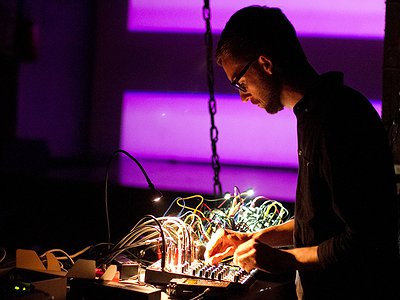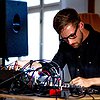Name: Mads Emil Nielsen
Occupation: Musician, Composer
Current Release: Refound on Arbitrary
Musical Recommendations: Cornelius Cardew: Treatise (1963-67), Carl Stone: Electronic Music from the Seventies and Eighties (2016) and Isolation by Frank Bretschneider (2015)
If you enjoyed this interview with Mads Emil Nielsen, you can find more information and recent updates on his website.
When did you start playing your instrument, and what or who were your early passions or influences? What what is about music and/or sound that drew you to it?
I started working with electronics (synthesizers, sampler, laptop), more intensively, around 2011. Before that I was playing piano, then drums at age 13, and my early influences for that were early soul, funk & jazz records. I was really into the work of Herbie Hancock – Headhunters, Thrust etc. – and liked how the drums/percussion and synthesizers sounded, I guess the mix between the very dry tape recordings and all the effects around it. All the instruments and sounds were extremely present, physical. I also liked how the sounds and instruments/musicians interacted – it was less about soloing, more about sound and simple layers, and felt more like one collective thing. That was inspiring to me in terms of working with my instrument (drums, later electronics) and playing with other musicians, and, in a more abstract way, for improvising and also producing. At the same time, I was interested in architecture and design, and that gave me a very visual approach to music/sound.
For most artists, originality is first preceded by a phase of learning and, often, emulating others. What was this like for you? How would you describe your own development as an artist and the transition towards your own voice? What is the the relationship between copying, learning and your own creativity?
When I started working a lot on my own material, between 2011 and 2013 or so, I was constantly searching and discovering new things – at some point I started focusing on certain directions/genres, and many of the recordings I did around that time sound a bit too much like copying and learning when I listen to them today, and I’m not really using them. Sometime during 2013 I felt like I was moving towards a more personal combination of sounds, elements. That’s also when I started using graphic scores, or finishing and recording from these – I’m often more creative when I work from a visual idea, some “drawing” in my mind, showing a structure and/or symbols, layers.
What were some of your main artistic challenges when starting out as an artist and in which way have they changed over the years?
In the beginning, I guess one of the main challenges was to figure out some kind of direction – this could obviously change, but I was asking myself whether or not I should go into more conceptual things, if the sounds/music I worked with should be about something specific. These days it’s still a challenge and important for me to figure out a more personal way of producing and combining sounds; another is the balance between improvisation and composition, both in the studio and live. For instance, being able to improvise more with smaller fragments, parts and making it sound clear and composed. Also, not to repeat myself and to keep coming up with new ideas – and the balance between different types of material: between simple, more melodic tracks and more abstract electronic/acoustic work, to make these different things and approaches work together somehow.
Tell me about your instrument, please. How would you describe the relationship with it? What are its most important qualities and how do they influence the musical results – and possibly even your own performance?
It’s a combination of several small things, but these days I don’t feel a very strong need to work with a specific instrument – the instrument is often the combination or “orchestra” of sounds; sometimes it’s a specific set of things/devices, sometimes it’s an archive of sounds running from my computer. There’s always some degree of randomness and surprises, uncontrollable things involved, which definitely influences the music; when using it live I need to be very focused on these elements, and in the studio I often emphasize them, as they add some kind of life and (hopefully) interesting texture.
Derek Bailey defined improvising as the search for material which is endlessly transformable. Regardless of whether or not you agree with his perspective, what kind of materials have turned to be particularly transformable and stimulating for you?
Starting points such as graphic scores and/or illustrations, a visual idea or concept to follow, and things like timecodes and limitations. For example: having a limited number and/or fixed type of sounds to be played within a certain duration.
How is playing live in front of an audience and in the studio connected? What do you achieve and draw from each experience personally? How do you see the relationship between improvisation and composition in this regard?
It depends – when playing with other musicians, live and in the studio, it’s often more improvised and focused around specific types of sounds or material; when playing live, solo, it’s composed and closer to the studio work, more about mixing and combining sounds, frequencies. I try to do something quite dense with a very clear structure/timeline, but I always leave room for improvisation – mainly it’s about reacting to the surprises occurring and playing with them, while knowing approximately what I want to do and for how long.
I guess I’m more focused when playing in front of an audience in general, but if the starting points etc. mentioned earlier are clear, recording and playing in the studio can be very focused too. Sometimes I tend to feel that being in the studio, producing material is enough, but I always enjoy performing live – the room and speakers become part of the instrument, in that way it feels very different from recording and working on small speakers.
Could you take us through a day in your life, from a possible morning routine through to your work? Do you have a fixed schedule? How do music and other aspects of your life feed back into each other - do you separate them or instead try to make them blend seamlessly?
At the moment, my life is quite simple and it’s mostly about work – I get up early in the morning, around 6:30 / 7:00 (a few years ago I would be working late evenings/nights), have breakfast and then go for a long walk, 30-45 mins. I start working around 9, with several breaks, until 17 / 18, most of the time in my studio at home, but when I’m traveling and/or need to do other types of work on certain days: mixing, theatre work, teaching, organizing, I try to keep the schedule.
Could you take me through the process of improvisation on the basis of one of your performances that's particularly dear to you, please? Where did the ideas come from, how were they transformed in your mind, what did you start with and how do you refine these beginnings into the finished work of art?
Again, from a graphic/visual starting point, a performance and recording as part of my recent collaboration with Andrea Neumann: we recorded a 15-minute improvisation based on simple, open graphic score “fragments”, for which we added individual timecodes and notes, so we both had different approaches and personal ideas about how to transform the visual material into sounds. Each of the 7 scores could be played once during the 15 minutes, and one should focus on the score/idea being played but at the same time listen and react to the other player. The intention was to turn this into a finished, 4-channel piece, so I had also added notes about movements, panning, placement of sounds etc., which I used later when mixing it. To make it denser we did one more recording, from which I selected certain parts and then combined these with the original; we also zoomed in on a selection of the scores, the more complex ones, and recorded additional sounds and loops. There was lots of editing and work on the sound and details involved, as well as tryouts and arrangement with the separate speaker channels – like copying certain parts and creating “shadows” of these, placed in certain speakers or rotating, used for transitions etc. The finished piece is very close to the original recording, and I’m quite happy with the result, also because it’s slightly mysterious and probably sounds like something in between an improvised recording and a constructed collage.



